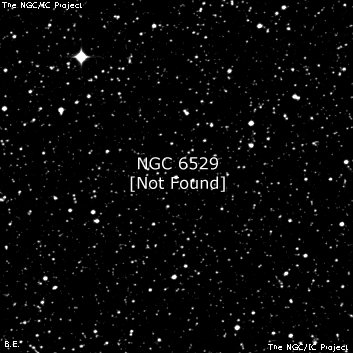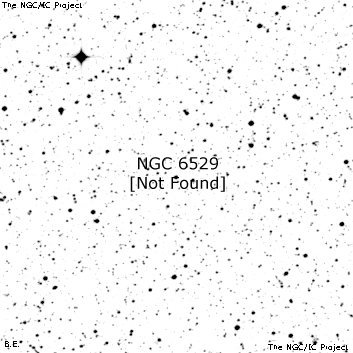NGC/IC Project Restoration Effort
(This is a very very beta version)
NGC6529


Basic Information
Location and Magnitude
Right Ascension: 18:5:29.0
Declination: -36:17:48
Constellation: SGR
Visual Magnitude:
Historic Information
Discoverer: Dunlop
Year of discovery: 1826
Discovery aperture: 9.0
Observational
Summary description: Cl in Milky Way
Sub-type: NF
Corwin's Notes
=====
NGC 6529 was apparently first seen by James Dunlop who claimed two
observations of it. His description reads, "A pretty large faint nebula,
round figure, 5' or 6' diameter, resolvable into very minute stars, with
nebula remaining."
Unlike most of Dunlop's nebulae, JH claims to have seen this one, though only
once. He lists an estimated position (both coordinates with +- signs, the RA
given to a full minute only) that is close to Dunlop's and calls it "A large
milky way patch, much compressed, one portion much more so."
However, checking the position on the SERC IIIa-J film shows nothing more than
a rather unremarkable part of the Milky Way. Nothing stands out that strikes
me as something that would catch an observer's eye. Compare this to other
Milky Way fields that have NGC numbers (e.g. NGC 6476 and NGC 6480) from JH's
sweeps -- there is nothing obvious here. I've put the nominal position in the
table.
I also checked the other nebulae seen in the same sweep; all are at about the
same declination, so there is no large error in that part of JH's observation.
A large RA error is possible, but I found nothing in the obvious places (plus
or minus one minute, ten minutes, etc.). Neither Lauberts nor Steinicke has
anything aside from the nominal position, though Lauberts has a "concentration
of stars" noted in ESO-B.
Finally, I checked the sweep itself (sweep 792 on 8 June 1837) when I went
over this field again in January 2016. The observation, number 24 in the
sweep, reads only "[17] 57" for the RA, and "3 26" for the NPD index (most of
JH's description is illegible). Fortunately, the very next object in the
sweep is a star, HD 166197. We know the position and proper motion of this
star, so can use it as a reference. Doing that we find for NGC 6529 18 07 02,
-36 17.0 (J2000). Unfortunately, this field is just as unremarkable on the
DSS as the one at JH's published position.
Perhaps a visual observer can turn up something here.



